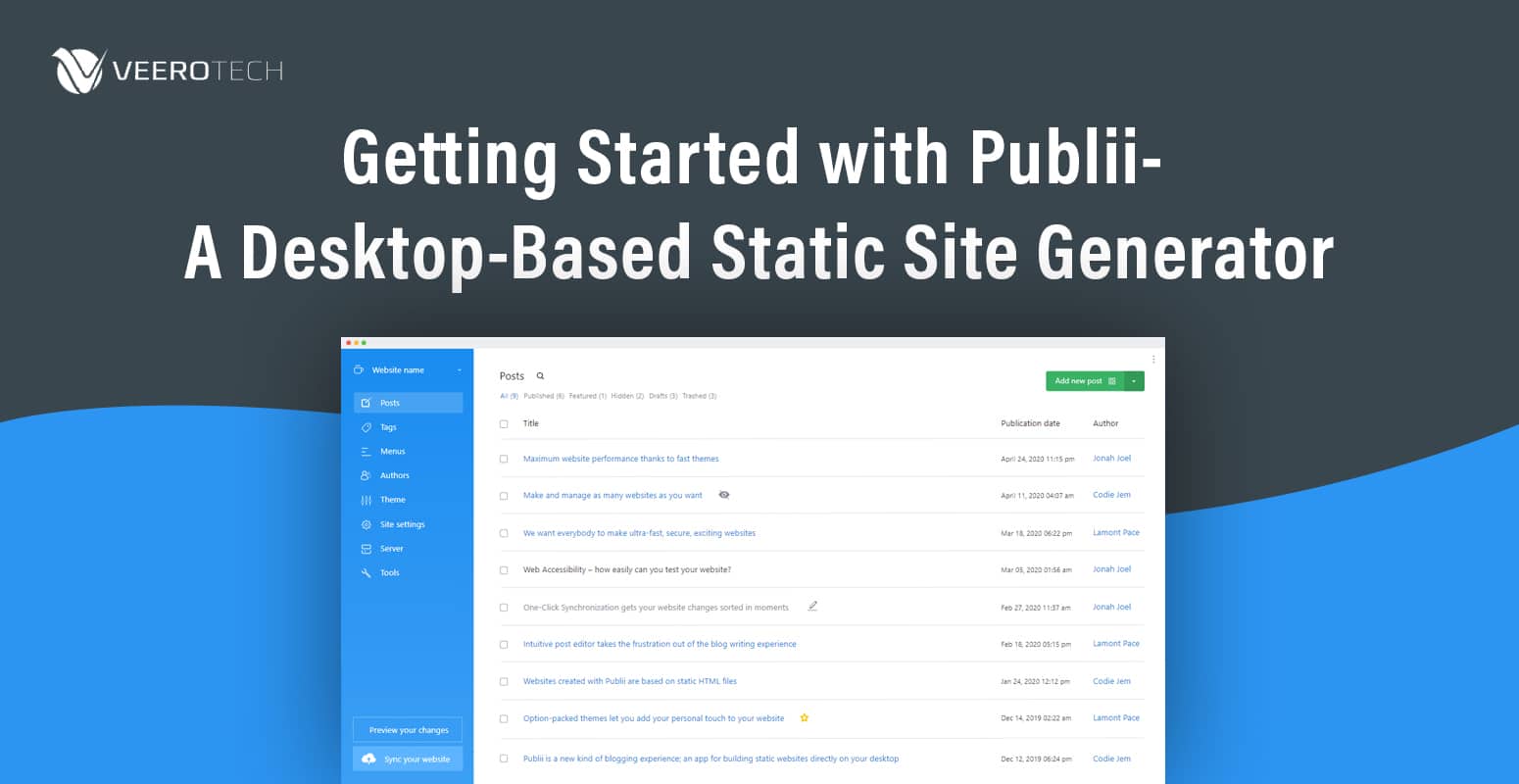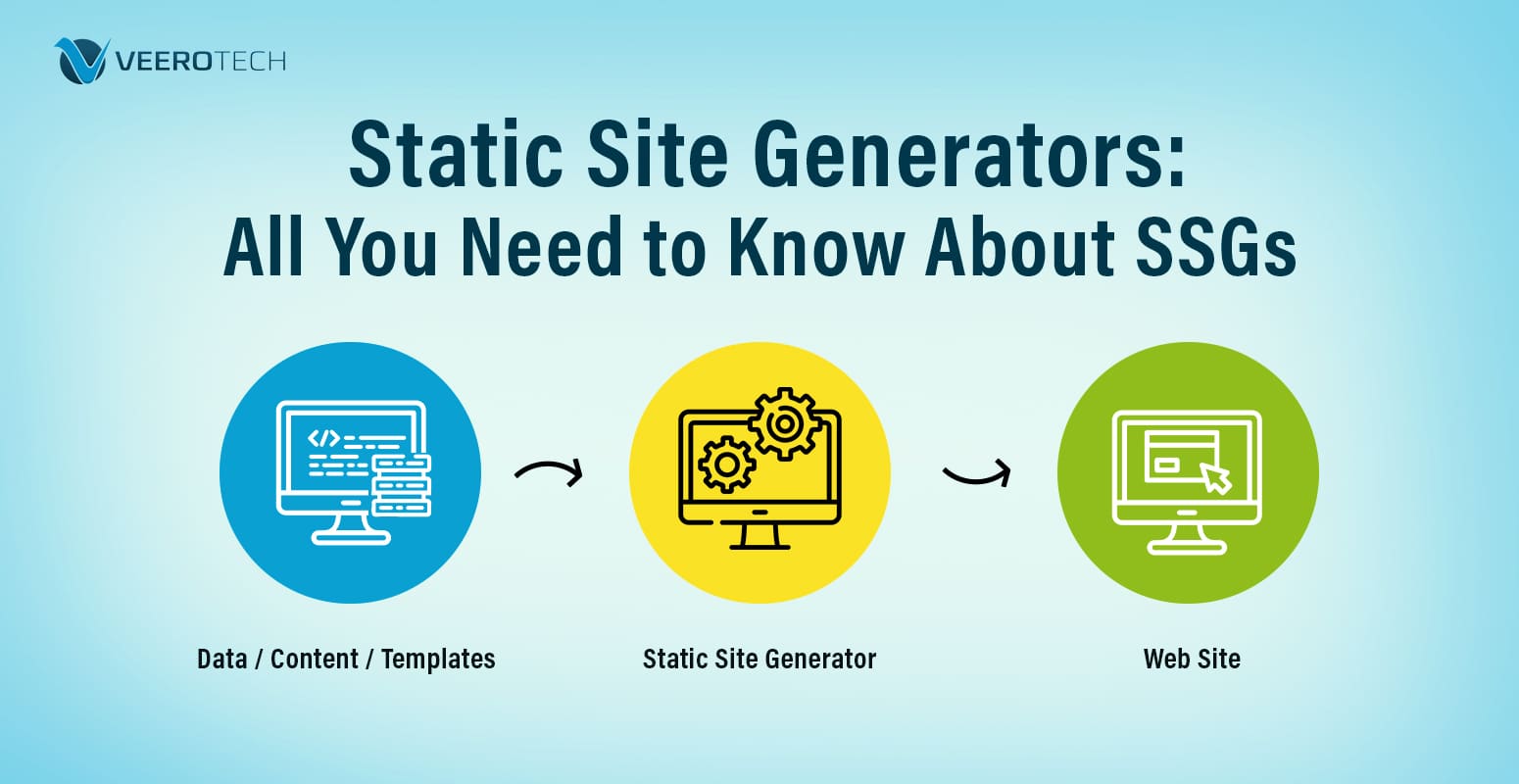There are several ways to create a website and several CMS options to choose from, such as WordPress and Joomla and site builder tools with drag-and-drop interfaces, but what about static site generators? A static site is precisely what it sounds like: a collection of pre-generated HTML pages. Other platforms take what you put into the CMS and process the information stored in the database, together with a template or multiple template partials, to dynamically generate the page before providing it to you in your browser.
The big question is, why should you use static site generators? What do they have to offer? In this article, we will attempt to answer the same.
What are Static Site Generators?
A program called a static site generator creates an entirely static HTML website from raw data and a collection of templates. A static site generator, in essence, automates the job of writing individual HTML pages and makes those sites ready to deliver to users ahead of time. These HTML pages load rapidly in users’ browsers because they are pre-built. Content management systems (CMS) – another sort of technology for managing online content, producing websites, and applying templates — offer alternative static site generators. (A template is a reusable format for online content; developers use templates to avoid repeating the same formatting.) Static site generators are commonly used as part of a JAMstack web development strategy.
The term “static” does not imply “unchanging.” An SSG creates a page only once, but a CMS creates it with each request. Users will never notice the difference because the ultimate effect is similar.
A “Headless” or “Decoupled” CMS is a related concept. These employ an interface to manage content, such as WordPress, but let other systems access the data through a REST API or a GraphQL API. As a result, an SSG like Eleventy may create a static website with WordPress page content retrieved from an internal server. The HTML files that result can be posted to a web server, but the WordPress installation should never be publicly available to anybody outside the company.
Static Site Generators: Pros and Cons
Now, you may ask — what are the benefits and drawbacks of employing a static site generator?
Advantages
- Performance: Because static site generators generate websites ahead of time rather than on-demand (as with a CMS), sites load somewhat faster in users’ browsers.
- Customization: Developers can develop whatever template they choose. They are not constrained by the fields offered by a CMS or by the built-in templates of a CMS.
- Lighter Backend: Static websites are lightweight and do not require as much code to execute on the server-side, whereas CMS-based websites frequently ask the server-side for the material.
Disadvantages
- There are few or no pre-built templates: The disadvantage of infinite modification is that it may take longer to get started.
- Many static site generators do not include templates; thus, developers will have to spend a significant amount of effort creating them from scratch at the beginning.
- The lack of a user-friendly interface makes it more difficult for non-developer users to publish content using a static site generator. There is no CMS interconnection.
Static site generators that are popular include Jekyll, Eleventy, Gatsby, Hugo, and Metalsmith. SSGs are accessible in the majority of languages. Frameworks like Next.js generate pages statically when possible and allow the developer to run server-side code when necessary. To find a static site generator of your choice, click here.
Why Should You Use Static Site Generators?
Let us now look at the advantages of employing a Static Site Generator:
1. Speed
The first advantage of a static site over a dynamic, database-driven site is faster page loading, which implies less processing is required before the page is provided. Some CMSs support caching, which implies that the initial visit to the website sees a dynamic version of the page and then keeps a cache of the page.
This implies that future visitors to the page will see the page faster than the first. If you have a routinely emptied memory or a low visitor count, future visitors may not benefit from storing and will all face higher load times.
2. Flexibility
CMSs typically limit your options because they are linked to a database with specified fields. To add a Twitter widget to some websites, you’ll usually need a plugin, a shortcode, or some bespoke functionality. In a static site, developers can directly put the widget into a file or via a partial/snippet. There are minimal constraints since those imposed by a CMS do not bind you.
3. Better Performance
Most CMS software has built-in or plugin-powered caching algorithms to guarantee that pages are created and reused as much as feasible. This is effective, but there is still the burden of maintaining, verifying, and regenerating cached pages.
Static sites can generate pre-cached pages that never need to expire. Files may also minify files before distribution to ensure the lightest load possible, and they can be readily published across global content delivery networks (CDNs). A static site will consistently outperform a CMS-powered counterpart based on a comparable template.
4. Fewer Server-side Dependencies
A standard WordPress installation necessitates the following:
- An appropriate operating system, such as Ubuntu or CentOS
- Web server, such as Apache or NGINX and its related extensions, as well as web server setups
- MySQL
- The WordPress program itself
- Any required plugins
- The theme/template code
These dependencies must be set up and maintained. WordPress needs less work than some other software, yet a single upgrade can still wreak havoc.
A static site generator may have the exact requirements as a dynamic site generator, but it may operate on a developer’s PC and is not pushed to a production server. An SSG creates client-side HTML files and accompanying assets that may be hosted on the server.
5. Improved Reliability
A CMS is a sophisticated system with several moving parts and sites of failure. If you run a WordPress site for an extended period, you will almost undoubtedly run across the dreaded “Failed to create a database connection” problem. Unexpected CMS issues might emerge due to unexpected traffic spikes, which overburden the server, crash the database, or limit active connections.
Serving a static site requires less effort. In many circumstances, the server only has to deliver flat files, making scalability based on traffic demand straightforward. It is still feasible to crash a web server or overload APIs, but it will require many more concurrent requests.
6. Superior Security
One final item to think about is website security. There is always the risk that adopting a popular CMS would leave your site insecure, as security flaws are constantly being discovered. You must maintain your site up to date and make the CMS login as safe as feasible. There is no login screen with a static site. The original material is stored elsewhere, and the assembled, created HTML is all that has to be submitted to your website, reducing risk. Any website that is open to the public has some risk, but whatever you can do to reduce it is better for your website in the long term.
A CMS opens the door to a slew of attack vectors. The login screen is the most prominent example: it is only as safe as the weakest user password. Be careful that any website that uses server-side code may expose you to vulnerabilities, such as sending spam emails through your contact form. It may not be clear that someone has acquired access; the worst offenders prefer to remain anonymous.
7. Client Control Considerations
You can spend weeks creating an appealing CMS theme only for the customer to destroy it within minutes of handover! Using a CMS is not always simple, but it gives content writers a lot of control. You can restrict permissions such as plugin installation, but it won’t stop someone from altering fonts, introducing clashing colors, adding bad photographs, or distorting the layout.
A static site can be as straightforward or as complex as you like. When utilizing Markdown or comparable flat files, editors are less likely to make mistakes or negatively impact page style. Some people will miss the CMS content administration panels; however, you have two options:
Use their current CMS to cleanse data before or enable simpler processes like updating Git-based files in StackEdit or Hackmd.io.
8. Version Control and Testing
The data in a database is very dynamic. A CMS allows users to add, delete, or update material on the fly. Wiping the entire site is only a few clicks away. Databases can back up databases, but you are still likely to lose some data even if you do so regularly.
In general, a static site is safer. SSGs can save content in the following locations:
- Flat files, which may then be version managed with Git or other similar systems.
- Private databases: Because data is only needed when the site is created, it does not need to be exposed on a public server.
Testing is further simplified because the site can be built and browsed from anywhere, even a client’s computer. You can design deployment mechanisms to create the site remotely and update the live server when new material is pushed to a repository, reviewed, and authorized with a little more work.
9. Design Freedom
The most significant advantage of a static site is that a frontend developer has greater leeway in how they design and create your site. Some CMSs operate in a specific manner, which limits your options. Page builders are available for many CMSs, but they generally need a lot of effort to get a particular piece of content in a specific spot on the page.
Instead of needing to customize or replace the HTML and CSS classes provided by the page builder tool, a static site generator allows you greater freedom to input your HTML and content into the website in the way you choose.
10. Data Protection
Many people prefer the concept of adding a plugin into a CMS to handle things like contact forms so that people can contact you about anything. Honestly, having an email address on the page that users can click on and email you directly is more accessible. This is because you must strive to avoid spam emails by including a captcha on the form and running an email service that will process form submissions and either store the form data someplace on your site or deliver it to you as an email. This is detailed information, but it is complicated by data privacy rules that govern how you store client data and how you use it.
Appraisal – Static Site Generators
Static site generators are fantastic, even if they have to cope with a job they were not designed for. To avoid exchanging one giant monolith for another, make your static site generator duties are manageable and straightforward. If you are using a static site generator to build an eCommerce or forum site, you are in for a lot of hard work and hours. On the other hand, using static site generators for corporate sites or blogs is a good idea, regardless of the nature of the content.



